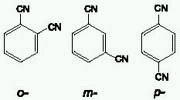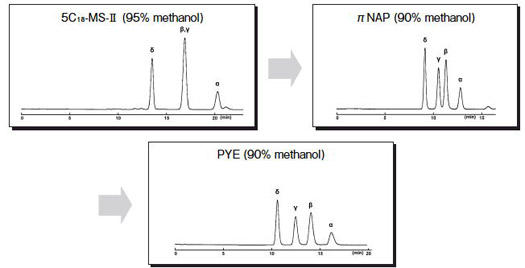COSMOSIL PYE
Features

- Pyrenylethyl group bonded stationary phase
- Separation with high molecular shape selectivity or π-π interactions
- Excellent separation for structural isomers
Product Information
Column Specifications
Comparison of π-π Interactions with πNAP
COSMOSIL PYE provides much stronger π-π interactions than πNAP.


Figure. Comparison of π-π interactions
Applications
Sterol

| Condition | ||
|---|---|---|
| Column Size | 4.6 mm I.D.x150 mm |  |
| Flow Rate | 1.0 ml/min | |
| Temperature | 30°C | |
| Detection | UV 210 nm | |
| Sample |
|
|
Phthalonitrile

| Condition | ||
|---|---|---|
| Column Size | 4.6 mm I.D. x 150 mm |  |
| Flow Rate | 1.0ml/min | |
| Temperature | 30°C | |
| Detection | UV 254 nm | |
| Sample |
|
|
Tocopherol

| Condition | ||
|---|---|---|
| Column Size | 4.6 mm I.D. x 150 mm |   |
| Flow Rate | 1.0ml/min | |
| Temperature | 30°C | |
| Detection | UV 295 nm | |
| Sample |
|
|
Capsaicins

| Condition | ||
|---|---|---|
| Column Size | 4.6 mm I.D. x 150 mm |  |
| Mobile phase | Methanol/ H2O = 70/30 | |
| Flow Rate | 1.0ml/min | |
| Temperature | 30°C | |
| Detection | UV 280 nm | |
| Sample |
|
|
Attention
- Methanol is recommended as a mobile phase for COSMOSIL PYE column. Acetonitrile is not recommended because it has many π electrons and interferes π-π interactions between a sample and the stationary phase.
- The stationary phase of COSMOSIL PYE, pyrenylethyl group, has a large UV absorption. When the stationary phase detaches from silica gel and elutes, even a slight quantity can be detected and causes baseline noise. In such a case, wash the column with tetrahydrofuran. Detachment of a small amount of the stationary phase does not deteriorate a column’s separation ability.
- COSMOSIL PYE column is not suitable for gradient analysis.
Usage information
| Column | 5 µm PYE | ||||
|---|---|---|---|---|---|
| I.D. (mm) | 2.0 | 3.0 | 4.6 | 10.0 | 20.0 |
| Washing method | 1. Remove buffer, salts and/or acid from column: wash for 10-15 min. using the mobile phase last used, without buffer, salts or acid. For example, if your mobile phase was 50:50 methanol/20 mmol/l phosphate buffer, wash with 50:50 methanol/water. 2. (If you used a buffer, always do step 1 first!) Remove adsorbed compounds and fix unstable baselines by washing with methanol and/or THF. |
||||
| Storage conditions | Short-term (up to a week): Remove buffer, salts and/or acid from column: wash for 10-15 min. using the mobile phase last used, without buffer, salts or acid. For example, if your mobile phase was 50:50 methanol/20 mmol/l phosphate buffer, wash with 50:50 methanol/water. Long-term: Remove buffer, salts and/or acid from column: wash for 10-15 min. using the mobile phase last used, without buffer, salts or acid. Then, replace the solvent with 70% methanol or acetonitrile : 30% water. In either case, tightly plug the column, and store in a cool and dry place. |
||||
| Usable pH range | pH2~pH7.5 | ||||
| Max. pressure | 20MPa | 15MPa | |||
| Temperature range | The maximum usable temperature is 60°C. However. for regular use, please use at a constant temperature between 20°C and 50°C. | ||||
| Usable solvents | Any solvent that will not dissolve the silica gel (such as alkaline solutions) or cleave the stationary phase (such as very acidic solutions) is usable. Note: For solvents with high viscosity, please watch the system pressure and keep it below 20 MPa. Also, please wash the column after using acidic mobile phases or solvents with high freezing points. |
||||
| Other instructions | - Buffer concentration is usually sufficient at 0.005 - 0.02 mol/L. - Always filter mobile phases using a 0.5 µm or finer filter before use. - As acetonitrile interferes with π electron interactions, please use a methanol-based mobile phase. - The baseline may become unstable due to the high UV absorption of shedded stationary phase. If this occurs, please wash the column with THF. A small amount of stationary phase shedding will not affect performance. - This column is not suitable for gradient analysis. |
||||
Downloads
References
Ordering Information
Analytical Column (Particle Size : 5 µm)
COSMOSIL PYE
(Storage) RT: Room temperature, A: Cool and dark, R: Refrigerator, F: Freeze









